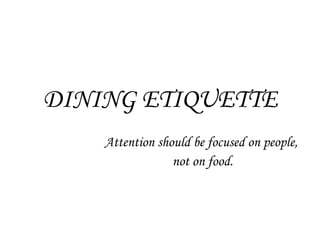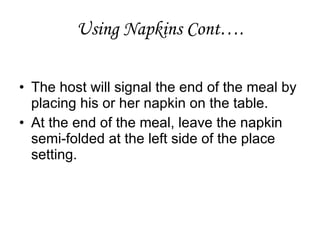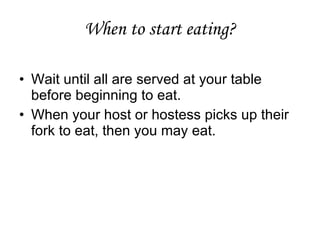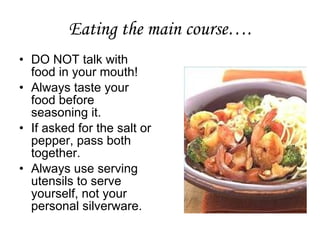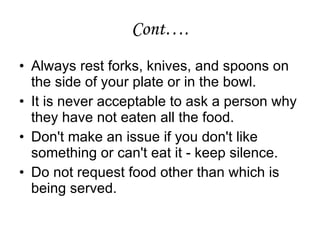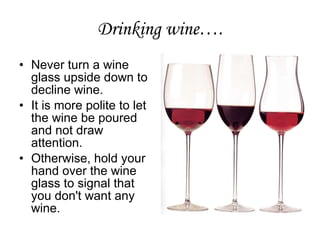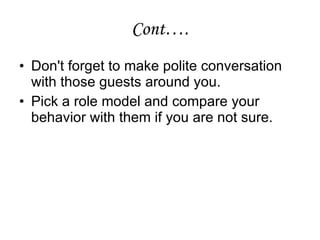Dining Etiquette
- 1. DINING ETIQUETTE Attention should be focused on people, not on food.
- 2. How to make restaurant reservations? Restaurant reservations are like any other appointment. If you make a reservation, stick to it. Call ahead if you’re going to be more than 15 minutes late. Cancel as far in advance as possible.
- 3. Getting seated…. Never take your seat before being invited to do so by your host.? The gentleman should always help the lady be seated. Do not ever run around trying to help the ladies not sitting directly next to you . Always take your seat from the left side of the chair.
- 4. How to use napkins? The meal begins when the host or hostess unfolds his or her napkin. This is your signal to do the same. Pick up your napkin by a corner and let it fall open. Do not shake it open. Don't clean the cutlery or wipe your face or nose with the napkin.
- 5. Using Napkins Cont…. The napkin rests on the lap till the end of the meal. If you excuse yourself from the table, loosely fold the napkin and place it to the left or right of your plate. Never place your napkin on your chair.
- 6. The host will signal the end of the meal by placing his or her napkin on the table. At the end of the meal, leave the napkin semi-folded at the left side of the place setting. Using Napkins Cont….
- 7. When to start eating? Wait until all are served at your table before beginning to eat. When your host or hostess picks up their fork to eat, then you may eat.
- 8. Table setting…. Eat to your left, drink to your right. At formal dinners, the food is served from the left and the dishes are removed from the right. Start with the knife, fork, or spoon that is farthest from your plate.
- 10. How to use the utensils? Hold knife in the right hand and fork in the left hand. Eat food with fork still in left hand. Difference between American and Continental styles.
- 11. Cont…. Hold the knife and fork in your hand with the tines pointed down throughout the entire eating process. If you want to take a drink put down both the utensils on the plate. Always rest forks, knives, and spoons on the side of your plate or in the bowl.
- 12. How to use glasswares? Hold the glass by its stem. Do not drink when there is still food in your mouth. Do not the empty the glass.
- 13. Drinking soup…. Dip the spoon into the soup, until it is about two-thirds full, then sip the liquid from the side of the spoon. Do not slurp the soup or insert the whole spoon into the mouth. Do not blow on the soup to cool it off.
- 14. Cont…. Do not put in big pieces of bread into your soup. Break the bread into small pieces by hand. It is perfectly fine to tilt the bowl slightly to get the last spoonful or two of soup.
- 15. Cont…. Tip the bowl away from you, not toward you. Place the spoon in the bowl when you want to rest. When you are finished, leave the spoon on the plate beneath the bowl.
- 16. How to eat bread? Use your fingers to remove bread from the serving plate/bread basket. Pass the basket/any food always to your right. If bread is handed out by a waiter, allow the waiter to use bread tongs to place it on the plate.
- 17. Cont…. Break apart the bread into small pieces using your fingers. Do not cut or bite. Add butter to each small piece of bread in your bread & butter plate. Place the butter knife horizontally on bread plate.
- 18. Cont…. Take enough butter from the butter dish and place it on your dish using the butter knife. Do not “double dip” into the butter dish. Carefully and neatly spread the butter and eat the small broken piece.
- 19. How to eat sandwiches? Small sandwiches may be picked up and eaten with your fingers. Large sandwiches should be cut with your knife before lifting and eating. Any hot sandwich served with a gravy requires a knife and fork.
- 20. Eating the main course…. DO NOT talk with food in your mouth! Always taste your food before seasoning it. If asked for the salt or pepper, pass both together. Always use serving utensils to serve yourself, not your personal silverware.
- 21. Cont…. Don't blow on your food to cool it off. Cut only enough food for the next mouthful. Do eat a little of everything on your plate. It is acceptable to leave some food on your plate if you are full or unable to eat. Do not "play with" your food or utensils.
- 22. Do not hold food on the fork or spoon while talking. Do not wave your silverware in the air or point with it. Try to pace your eating so that you don’t finish before others are halfway through. Once used, your utensils, including the handles, must not touch the table again. Cont….
- 23. Cont…. Always rest forks, knives, and spoons on the side of your plate or in the bowl. It is never acceptable to ask a person why they have not eaten all the food. Don't make an issue if you don't like something or can't eat it - keep silence. Do not request food other than which is being served.
- 24. Eating desserts…. Dessert is a course that typically comes at the end of a meal. It usually consists of sweet food. Common desserts include cakes, cookies, fruits, pastries, ice cream, and candies. Always use the dessert spoon and the dessert knife.
- 25. Drinking wine…. Never turn a wine glass upside down to decline wine. It is more polite to let the wine be poured and not draw attention. Otherwise, hold your hand over the wine glass to signal that you don't want any wine.
- 26. Placing knife, fork and spoon after completing food….
- 27. Using arms and legs…. Rest your arms in your lap when you aren't eating. If you gesture with your hands during a meal conversation, you may rest only your forearms on the table. Keep the arms still when in your lap, and avoid the urge to fidget.
- 28. Cont…. Don't rest your elbows on the table while you dine. Never stretch your arms at the table. It signifies boredom. If you feel the urge to stretch or fidget while dining, excuse yourself from the table and take a break.
- 29. Simple, Good Manners…. Always respond to an invitation within a week of receiving it. Dress properly as per the occasion. NEVER attempt to "out dress" the host! Be punctual - never more than 10 minutes late. If you wish to bring a guest as your partner, you should always check with the host first.
- 30. Cont…. Never carry any gifts for the host or the hostess. Avoid loud eating noises such as slurping and burping as they are considered very impolite. Don't stretch across the table crossing other guests to reach food or to pass the food. Picking teeth or licking fingers are very unattractive!
- 31. Cont…. Drinking too much wine can be very embarrassing! If you drop a piece of food on the table, don't panic. Don't correct others if they aren't using proper etiquette.
- 32. Cont…. Don't forget to make polite conversation with those guests around you. Pick a role model and compare your behavior with them if you are not sure.
- 33. T H A N K Y O U

